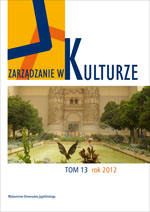Teatr, taniec, liturgia (część II)
Theatre, Dance and Liturgy
Author(s): Tadeusz KornaśSubject(s): Cultural Essay, Political Essay, Societal Essay
Published by: Wydawnictwo Uniwersytetu Jagiellońskiego
Keywords: Theatre; Liturgical dance; Liturgy; Christian rite; The drama of the medieval church; Alternative theatre
Summary/Abstract: The “Węgajty” Theatre School /Schola/ which operates in Warmia under the management and supervision of Wolfgang Niklaus, tries to reconstruct the medieval liturgical plays. After a few centuries of absence from the public scene in the Middle Ages (or else of concealed presence in the form of folk and ritual spectacles), the medieval theatre became reborn precisely within the Church. – In all likelihood, before the 10th century, short dramatized forms, known as liturgical plays, were presented as part of the liturgy. Like all ceremonial liturgy, they were meant to be sung, nearly in their entirety. Gradually, they were extended to form fully-fledged liturgical plays. When reforming the liturgy and tidying up liturgical books the Council of Trent (1545-1563) at the same time banished liturgical plays from Church interiors. No doubt, it was a legitimate decision on behalf of the Church as more and more lay and even satirical elements began to appear in the church liturgy. Yet, records of liturgical plays, in many cases accompanied by a musical notation and precise “stage” directions, have also been preserved until the present day. Towards the end of the 20th century, many singers, particularly those specializing in old music, tried to reconstruct this form, yet they did so exclusively by adopting the concert form (sometimes even the form of plays, but not those of liturgical spectacles). The international team grouped in the Theatre School /Schola/ has embarked on an extremely risky task – for after a few centuries of its absence from the public scene, it tried once again to incorporate the liturgical play into its natural environment – by performing it in the course of the liturgy. In order to fully comprehend this phenomenon, it is worth taking a closer look at Christianity’s attitude towards the theatre. In the present article, I focus chiefly on the liturgical context associated with the activity of the “Węgajta” Theatre School. I write about the theatre in the Bible and I try to describe how the attitude towards it evolved throughout centuries; I also write about dance in the Church and finally about the most important Christian “spectacle” – the Holy Mass.
Journal: Zarządzanie w kulturze
- Issue Year: 13/2012
- Issue No: 3
- Page Range: 223-238
- Page Count: 16
- Language: Polish

